Exploring New York’s Industrial Past in "Cathedrals of Industry"
Join photographer Michael L. Horowitz for a journey through 50 years of photographs!


With all the skyscrapers, congestion, and huge crowds dominating New York City, it can be easy to overlook some of its more isolated refuges. But these places are all around us—that is, if you know where to go. From historic districts smaller than a block to alleys and small private streets, there are many peaceful places hidden in plain sight, often right in the middle of New York City’s busiest areas.
Now, here are 12 courtyards hidden in plain site for you to scope out. Though most are not open to the public, they are nonetheless notable for their historical secrets, quaint atmosphere, and stark contrast to the surrounding hustle and bustle.
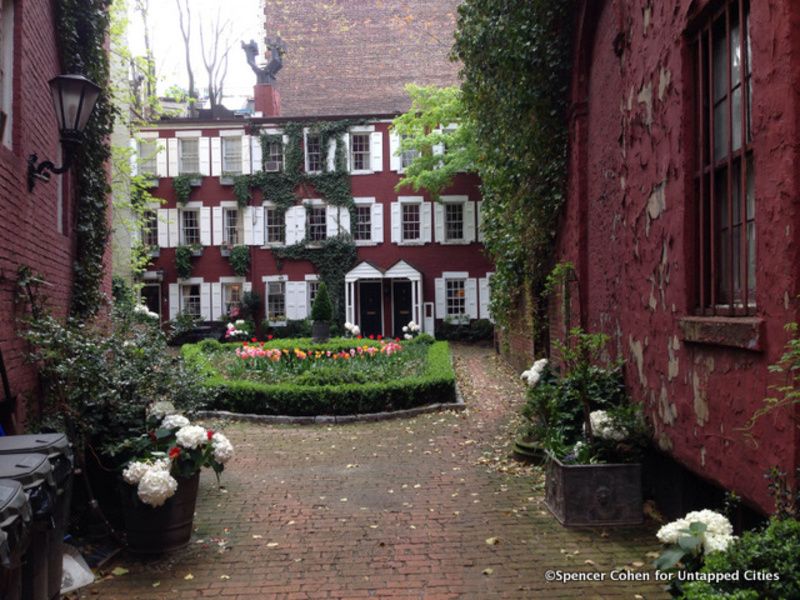
Starting at Christopher Street, you’ll notice that Grove Street continues west, curving before ending on Hudson Street. Along the street, you’ll notice a tiny gate with a black sign in gold lettering reading “PRIVATE COURT, No Trespassing.” Hidden behind the gate is a small courtyard with 19th century townhouses—Grove Court!
Samuel Cocks likely created the alley in 1848, with the townhouses complete by 1854 (although others have dated them to 1820), to house tradesmen and other workers in efforts to attract customers to his nearby business. It was nicknamed “Mixed Ale Alley” for the cheap alcohol produced there, and was far from the desirable place to live that it is today. Now, it’s home to much sought after Federal Style apartments, retaining its old-style gate and cobblestone road. It’s truly a one-of-a-kind courtyard in New York City and a West Village gem.

We were pleasantly surprised to stumble upon Clinton Court, a quiet courtyard and former carriage house just blocks from the bustling streets of Times Square. You can find it tucked neatly away in Hell’s Kitchen, on West 46th street between 9th and 10th avenues.
Built before 1800 as a stable, today it is a private, multi-residence community. Inside are benches, a winding staircase, glass-paned doors, and spidery green trees that cast a layer of shade over it all. But if you’re in the area, it’s still worth a peek inside—if you don’t believe in ghosts, that is, as it’s supposedly one of New York City’s most haunted places.
Read more about Clinton Court here.

Milligan Place, tightly squeezed between two buildings on 6th Avenue near 10th Street, is home to one of New York City’s quaintest courtyards. It also has an equally whimsical cast-iron doorway featuring “Milligan Place” in fancy script. Originally built as working class boarding houses for Basque waiters, the 1850s homes enclosing it were home to renowned playwright Eugene O’Neill and George Cram Cook, founder of the Provincetown Players.
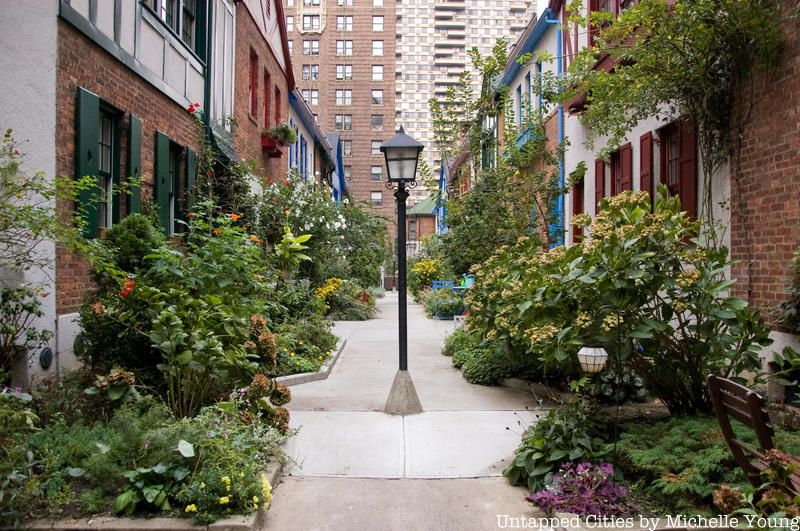
The Upper West Side also has its share of quaint courtyards, and among them is Pomander Walk, an English-inspired street hidden among buildings. With the entrance on 95th Street and West End, this street is unknown even to many locals, especially since only residents with a key to the gate can access it.
Irish immigrant, restauranteur, and hotelier Thomas Healy created the street in 1921, when it was called a “colony.” The architects, King & Campbell, were said to have taken “slyly humorous delight in making [the Pomander Walk] houses miniature copies of much more pretentious town mansions.” (The New York Times, April 19, 1921). The walk was named after the set of a popular play at the time called Pomander Walk, which featured a London street from the Georgian Period.
Read more about Pomander Walk here.

Now a historic district, Sniffen Court is a small private alley in Murray Hill between 3rd Avenue and Lexington Avenue. Its roots begin with John Sniffen, who built ten carriage houses lining the alley in 1863-64. These carriage houses are now apartments, but with two white pegasus statues on the back wall, it retains a sense of nostalgia for the good ol’ days.

Turtle Bay Gardens circa 1920. Photo from Library of Congress.
Here’s one you might know about—Turtle Bay Gardens, between 47th and 48th streets and Second and Third Avenues in Manhattan! This historic district, consisting of townhouses and a common courtyard, had its beginnings when Charlotte Martin, a descendant of the Dutch settlers, brought 20 run down houses in 1919 and remodeled them, creating a shared garden esplanade between them. A replica of the fountain in the Villa Medici also sits in this garden, and with neighbors in the vicinity all using and tending to this peaceful enclave.
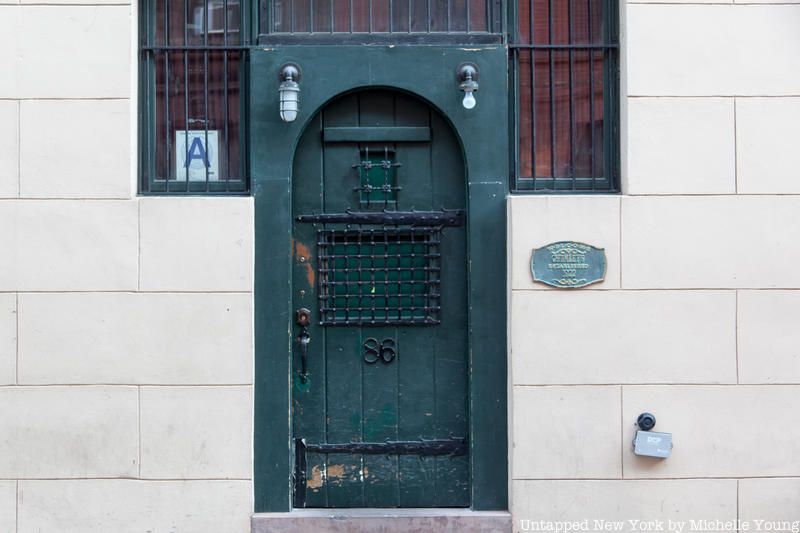
Fans of the speakeasy Chumley’s will remember this courtyard, just off Barrow Street in the West Village. Nestled behind townhouses, Pamela’s Court is a secret passageway to Chumley’s that hasn’t been in operation since the 2007 collapse of Chumley’s wall. The building has served many functions, first as a blacksmithery and later as a stop on the Underground Railroad before the Civil War. In 1922, the speakeasy was founded by Leland Chumley and quickly became a hangout for literary legends. Despite the wall’s collapse, today, the courtyard retains its novelty and lore among New Yorkers.
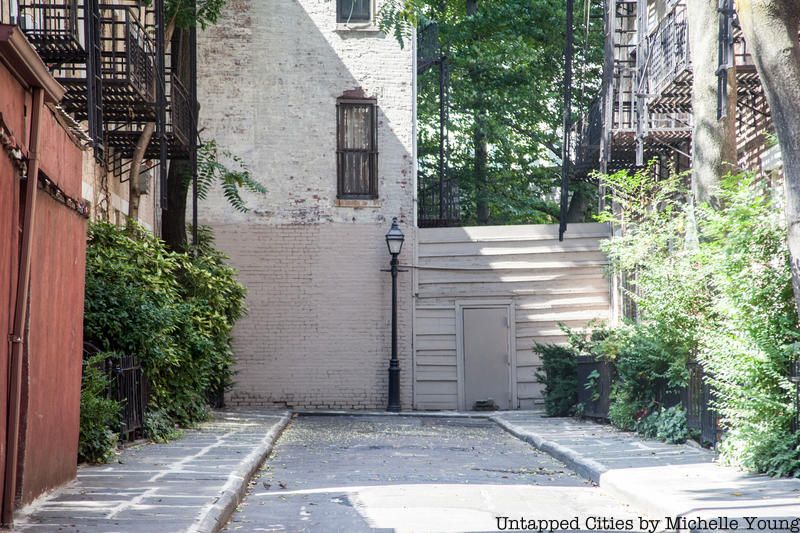
Patchin Place, squeezed between Greenwich Avenue and Avenue of the Americas, is undoubtedly one of New York City’s cutest alleyways. It’s also filled with fantastic historic secrets! Located on the site of a former farm, the row of quaint, brick houses was built around 1850 for Basque waiters working at the Brevoort Hotel. The alleyway is not only home to one of the last 19th century gaslamps in New York City (now powered by electricity), but the gated community was also home to none other than writer and poet E.E Cummings, in addition to Marlon Brando’s sister, Theodore Dreiser, and Djuna Barnes. You can’t see much of Patchin Place through the gates, but if you’re in the area, stop by and check out its gaslamps!

Macdougal-Sullivan Gardens, a historic district a bit south of Washington Square Park, has a central, communal courtyard for residents of the vibrantly colored townhouses lining the block along Sullivan and MacDougal Streets between Bleecker and Houston. Specifically, it consists of house numbers 74–96 MacDougal Street and 170–188 Sullivan Street.
The Landmarks Preservation Commission says that upon seeing the houses and garden, visitors may feel themselves being “transported back to a mid-Nineteenth century street scene.” And that’s a fact.
The district consists of 22 homes built in Greek Revival style between 1844-1850. The district owes its survival to businessman William Sloane Coffin, who bought the houses in 1922 to save old, single-family houses in the area. The houses were redone in a neo-Federal style, and the interior garden was created for residents, which have included several celebrities.

Sitting behind the row of buildings at Washington Mews, including the new Deutsches House building at NYU, is a small courtyard complete with trees and benches. Directly overlooking it is the townhouse at 64 Washington Mews, which has a balcony that provides some great courtyard views.
The gated street itself —Washington Mews— dates back to the 19th century horse and carriage days. It is on a former 18th century farm, though by the 1830s, the Mews were eventually laid out as an alley for horse stables and carriage houses that served townhouses facing Washington Square.
Check out more former mews in New York City here.

Amster Yard may look like just another quaint garden, but it has been the subject of intense controversy. Located at East 49th Street between Second and Third Avenues, the community became angry when some of its buildings were demolished. It has since been restored in 2003 with replications of its original 19th century buildings. Today, the garden, enclosed by the brick buildings, continues to host lectures, exhibits, readings, classes, and other events. Although it is relatively hidden, this gem is open to the public, so be sure to scope this one out!
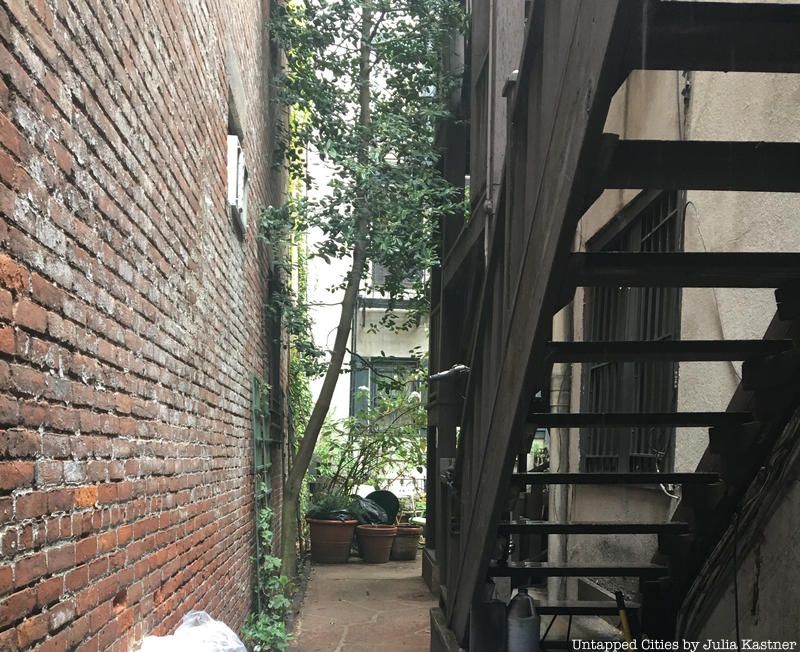
Scouting New York uncovered a hidden courtyard in the West Village at 93 Perry Street. According to them, it is an example of a “back house,” or a territory built behind a main dwelling before the restrictive property laws of the 1860s-70s that aimed to prevent overcrowding. Scouting New York further states that the building was created in 1827, with arched French-styled windows on the second floor offering great views of the courtyard.
Local lore contends that the famous horror author H.P. Lovecraft paid a visit to 93 Perry Street, writing of it, “The archaic lanes and houses and unexpected bits of square and court had indeed delighted me.”
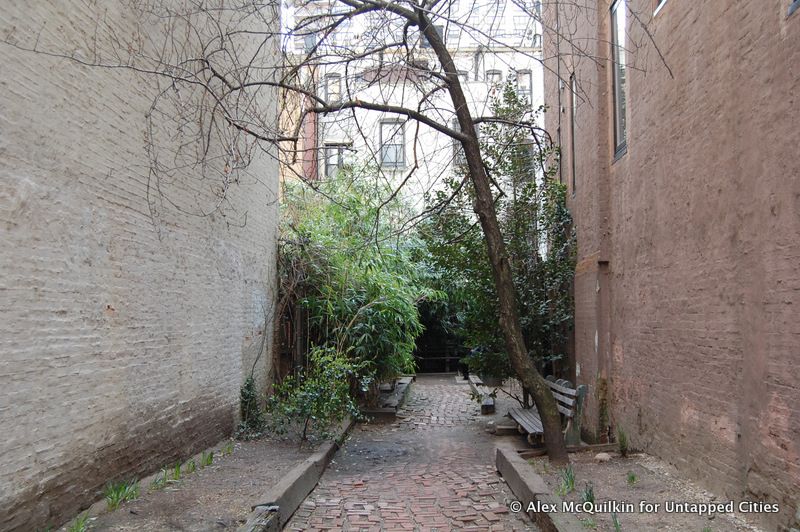
While on a mission to find one of the smallest parks in New York City on the Upper West Side, we came across Septuagesimo Uno, somewhat awkwardly squashed between two four-story brownstones at 256 West 71st Street. It’s one of the city’s tiniest parks, although the Parks Department even calls it a “triangle/plaza.”
In reality, however, it’s none of these options. It’s more of a forgotten dead-end alley overrun by nature, and at two-fifths of an acre in size, it’s a refreshing contrast to the city’s big, popular parks.
Septuagesimo Uno was acquired by the city through condemnation on March 28, 1969, near the height of the city’s budget woes. But the park wasn’t officially opened by the parks department until May 1981. Since then, Septuagesimo Uno has become popular among an in-the-know group of locals who crave its quiet seclusion—although there really isn’t much to do there.
Next, check out 6 Hidden Alleys and Small Private Streets in NYC’s Greenwich Village and 8 Beautiful Historic Districts in Manhattan Smaller Than One Block.
Subscribe to our newsletter